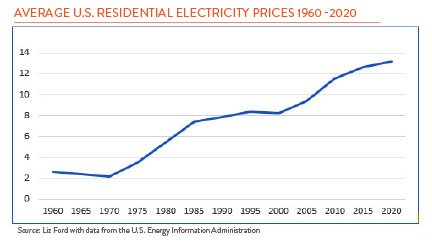Installing solar panels has been a goal since I bought my home in 2019. As my little ranch house is a classic 1971 fixer upper, my solar dreams have gotten shelved somewhere between asbestos abatement and eradicating carpenter ants. This changed for me in August with the Intergovernmental Panel on Climate Change’s report that we’re set to pass 1.5C of warming by 2040. The news made me feel powerless and desperate for anything to do in response. Galvanized, my south-facing roof and I are now ready to join the fight.
Researching a big investment is never easy and solar is no exception. The average U.S. residential rooftop solar array costs around $20,000 and has an expected life of 25-plus years. This doesn’t include accessories, like heat pumps or batteries.
Solar company ads can make the investment appear painless. However, it’s important to understand the details to avoid unexpected cash outlays, especially if you’re on a tight budget.
The Economics of Solar
Net Metering – Most solar owners remain connected to the grid, but this relationship becomes a two-way street. You get credits from your utility for contributing your excess solar to the grid, then these credits (generally good for a year) pay for electricity you draw at night or on cloudy days. If you don’t use all your credits, you lose them with no cash payoff. So, it’s important not to get more panels than you need. Your electricity bill won’t go away completely as credits don’t apply to some basic fees. It can also take up to a year to see the full reduction in your bill, especially if you install in the fall. The long, sunny days of summer will be a major source of your credits for the year.

Electricity Inflation – Since 1960, residential electricity prices have risen at an average rate of 2.8% per year (see graph). If your solar generation goes as planned and covers most of your electricity needs, you’ll be trading these variable (and likely rising) prices for the fixed cost of your solar project. This makes the most economic sense if you plan to own your home for a long time and can benefit from the potential savings yourself. Future home buyers may or may not appreciate the value of your solar project.
Financing – Paying in cash will have the lowest project cost, but for many of us this isn’t a viable option. Thankfully, a wide variety of loans are available. Those looking for the lowest monthly payments may be eligible for low-rate “solar mortgages” requiring little to no money down. Payments are generally a little higher than your current electricity bill, with the idea that much of your bill will eventually be offset by solar credits. The trade-off is that these 20-plus year loans will likely have the highest total project cost given the length of financing.
Unexpected Startup Costs – Unfortunately, you may need to budget for more than the solar provider’s estimate. You may need roof repairs, tree trimming, and electrical upgrades for a successful installation.
So where am I now? After consultations with several solar companies, I feel confident that I can get this project done by the end of 2022. They’ve helped me understand how many panels I will need, and I’ve decided to include heat pumps which will decrease my gas bill but raise my electrical use. Long-term financing is within my budget, but I also want to give myself time to save a larger cushion for unforeseen extras. The aspect I’ve found most challenging, though, is planning for future renewable upgrades. Do I include more panels to charge the electric car that I don’t own yet?